- Home
- Sue Grafton
X Page 7
X Read online
Page 7
This was the same cardboard carton in which I’d found Pete’s tape deck wedged some months before. I’d since moved the recorder to my bottom drawer. The old Sony was oversize and had the look of an antique compared to those currently in use. On the cassette he’d left in the machine, I’d found the illegally recorded phone conversation he’d used in the blackmail scheme that eventually got him killed. It really was a wonder he’d lived as long as he did.
I emptied the box, hauling out file after file: bulging accordion-style folders, correspondence, case notes, and written reports. Byrd-Shine had a document-retention policy of five years, so most were long out of date. The major portion would be duplicates of reports sent to the various attorneys for whom Ben and Morley had worked. My plan was to assess the contents, set aside anything sensitive, and deliver the remainder to a shredding company. I wasn’t sure what would qualify as “sensitive,” but occasionally lawsuits drag on for years, and it was always possible a case might still be active, though no longer under the purview of the now-defunct agency.
Pete must have cherry-picked these client files, perhaps hoping to generate business after the agency was dissolved. Given his questionable code of conduct, he would have felt no compunction about reaping the benefits of Ben and Morley’s split. The fifteen files I counted seemed randomly assembled. Pete probably had a game plan, but so far I hadn’t discerned the underlying strategy.
Among the cases, the only one I remembered was a lawsuit in which an attorney named Arnold Ruffner had hired Byrd-Shine to do a background check on a woman named Taryn Sizemore, who was suing his client for intentional infliction of emotional distress. The defendant, Ned Lowe, was accused of stalking, harassment, and threats. His attorney paid Byrd-Shine a big whack of money to find evidence that would undermine the plaintiff’s credibility. Morley Shine had handled the matter.
At the time, I was still in training, so I wasn’t involved. Eventually, the suit was dropped, so Morley must have delivered the goods.
Remembering Ruthie’s caution about Pete’s penchant for hiding cash, I turned each file upside down and riffled the pages. I wasn’t even halfway through the process when a piece of folded graph paper fell out. I opened it and found myself looking at handwritten columns of numbers, eight across and twelve down, the numbers grouped in subsets of four.
I checked the other side of the paper, which was blank. There were no torn edges, so it didn’t appear the page had been removed from a financial ledger. No dollar signs, no commas, and no decimal points. Many numbers were repeated. Eight of the twelve lines ended in sets of zeroes, which might have been place holders used to round out the grid. I couldn’t imagine what it was, but I assumed the data was significant, or why would he have hidden it? Knowing how devious he was, I didn’t want to underestimate his thinking process—but I also didn’t want to overestimate his smarts. I put the paper in the outer compartment of my shoulder bag and went back to the job at hand.
I thought the case names I came across would trigger memories, but it was the sight of Ben Byrd’s precise penmanship that called up images of the past. He’d used a fountain pen and a particular brand of ink, so his field notes were easily distinguished from the scribbles Morley had made with assorted ballpoint pens. All the final reports were neatly typed. The originals had gone to the clients’ attorneys and the carbons were filed in descending date order, the most recent on top. Ben had insisted on storing the rough draft notes with the finished versions, making sure both were retained. I could remember a couple of occasions when critical information hadn’t made it into the typed report, and it was Ben’s policy that had saved the agency embarrassment.
He and Morley had been a study in contrasts. Ben was a statesman and a gentleman, tall, elegant, and dignified, while Morley was the rumpled, overweight jack-of-all-trades who generally flew by the seat of his pants. Morley relied on intuitive leaps, where Ben operated by the methodical accretion of detail. Morley was quick off the mark and insights came to him intact. At the outset, he couldn’t always justify his position, but nine times out of ten he was right. Ben might come to the same conclusion, but his was a carefully rendered composition, where Morley’s was a quick sketch.
In one expandable file folder, I found a stack of annotated index cards, wrapped with a rubber band that broke the minute I lifted the packet from the depths; Ben Byrd’s bold blue cursive again. He was the one who’d taught me the art of the interview without the use of a notebook or tape recorder. Didn’t matter to him if he was dealing with a client or a culprit, an adversary or a confidential informant. His policy was to listen with his whole being, mind open, judgment held in reserve. He absorbed tone and body language, trusting his memory as the conversation went on. After each exchange, he converted facts and impressions into written form as soon as possible, using index cards to record the bits and pieces regardless of how unimportant they might have seemed in the moment. He was also an advocate of shuffling and reshuffling his makeshift deck of cards, convinced that even a random rearrangement would sometimes suggest a startling new view. Until that moment, I wasn’t even aware how thoroughly I’d absorbed the lesson. I’d forgotten his habit of dating his index cards and decided it might be a smart idea to adopt the practice myself. I could see the virtue of keeping track of the order in which information was acquired along with the content itself.
After that brief detour, I worked quickly, doing a spot check here and there, still hopeful I might find pertinent financial statements. That Pete might slip personal business papers in among agency documents made no particular sense, but I didn’t want to rule out the possibility. The folders themselves were shopworn, tabs ragged and bent, a consequence of the box’s being too shallow for the contents. Since banker’s boxes are designed to accommodate standard-size files, I was perplexed by the poor fit.
I studied the bottom of the empty box, noting that the cardboard “floor” was uneven along the edge. I’d constructed many identical cartons, which arrived in flat packages for assembling in place. There were always tricky diagrams labeled Flap A and Flap B with arrows pointing this way and that. I thought of it as an IQ test for office employees whose job was to pack up documents for long-term storage. The puzzler was that the final flap should have fit seamlessly, and here it did not. I retrieved a letter opener from my pencil drawer and wedged it into the gap, using it as leverage. I cringed at the harsh shriek of cardboard on cardboard, but did succeed in popping out the makeshift rectangle that had been cut to fit.
Under it was a ten-by-fifteen padded mailing pouch, addressed to a Father Xavier, St. Elizabeth’s Parish in Burning Oaks, California, a small town a hundred and twenty-five miles northeast of Santa Teresa. The return address was 461 Glenrock Road, also in Burning Oaks. The package was postmarked March 27, 1961, roughly twenty-eight years before. I removed the mailer and studied it, front and back. Originally, the padded envelope had been taped and stapled shut, but someone had already opened it, so I felt at liberty to take a peek myself.
Inside, there were a number of items that I removed one by one. The first was a red-bead rosary; the second a small Bible with a red leatherette cover embossed with LENORE REDFERN, CONFIRMED TO CHRIST, APRIL 13, 1952. The name was written again on the frontispiece in a girlish cursive. Knowing little about the Catholic Church, I imagined young girls were baptized or confirmed at age twelve or so. I wasn’t sure if baptism and confirmation were synonymous or different religious rituals, but I thought the taking of a First Communion figured in there somewhere.
I reached into the mailer again and removed a crude handmade card on red construction paper. The simple lettering said Happy Mother’s Day! In the center, there was a child’s diminutive handprint outlined in white tempura paint with the name April printed under it, doubtless under the guiding hand of an adult. At the bottom of the mailer was an unsealed envelope that contained a child’s birthday card. On the front was a teddy bear holding a balloon with a bu
tton affixed. The button read: NOW I AM 4! Inside, the handwritten message read: I love you with all my heart! XOXOXOX Mommie
Four one-dollar bills had been enclosed; one for every year of the child’s life.
I returned to the Bible, where I found a black-and-white snapshot tucked into the New Testament. The young girl pictured wore a white dress, a headband with a short white veil attached, white socks edged with lace, and black patent leather Mary Janes. She was posed on the front steps of a church. Dark hair, dark eyes, and a smile that revealed endearingly crooked teeth. In the current context, I thought I was safe assuming this was Lenore Redfern.
Tucked in the back cover of the Bible, almost as an afterthought, I found a wedding announcement, dated March 13, 1988, clipped from the Santa Teresa Dispatch.
LOWE-STAEHLINGS
April Elizabeth Lowe and Dr. William Brian Staehlings were united in marriage on February 20, 1988, at the United Methodist Church in Santa Teresa, California. April, the daughter of Ned and Celeste Lowe of Cottonwood, is a 1981 graduate of Pomona College and more recently the Santa Teresa Business College. She’s currently employed as a legal secretary for the law firm of Eaton and McCarty. Dr. Staehlings is the son of Dr. Robert Staehlings and the late Julianna Staehlings of Boulder, Colorado. A graduate of the University of California, Santa Teresa, and Loma Linda University School of Dentistry, Dr. Staehlings opened a private practice, specializing in orthodontics, with an office on State Street in Santa Teresa. The newlyweds honeymooned in Hawaii and are now “at home” in Colgate.
April, not yet four years old when the items were mailed to Father Xavier, had done all right in the world. She’d managed to educate herself, find gainful employment, and fall in love. I read the wedding announcement again and stopped three sentences into it at the mention of the bride’s father. Ned Lowe was the defendant in the lawsuit I’d just come across. I was assuming Ned Lowe was April’s father and Lenore Redfern was her mother. Ned was now married to a woman named Celeste, so if Ned and Lenore were April’s parents, they’d either divorced or Lenore had died and he’d moved on. Pete must have spied the announcement in the paper and added it to the old file, creating an addendum to the now-dead legal dispute.
The remaining item was a four-by-six-inch red leather frame that contained a studio portrait of a mother posed with a little girl sitting on her lap. The mother-daughter relationship was reinforced by the fact that the two wore matching red plaid tops. The little girl’s wispy blond curls were shoulder-length and her face was lighted by a smile that showed small perfect teeth. She held an Easter basket in her lap that contained a big blue bunny, dyed Easter eggs (one pink, one blue, one green), and assorted foil-wrapped chocolates nested in bright green paper grass. Lenore and April? I put the two photographs side by side. Lenore at her confirmation and Lenore with her child.
The grown-up Lenore bore only a passing resemblance to her younger self. Her hair was now blond and worn in a style vaguely suggestive of vintage movie star glamor. She must have been in her late teens or early twenties; her pale complexion was so smooth and clear, it might have been carved from alabaster. Her expression was withdrawn, anger turned inward, as though motherhood had somehow robbed her of animation. The contrast between mother and daughter was troubling. The camera had caught the child close to bouncing, happy and secure and utterly unaware of her mother’s demeanor.
I returned the items to the pouch and then returned the pouch to the bottom of the box and wedged the cardboard panel in on top. I assumed Pete had created the hidey-hole, though I couldn’t be sure. I shoved the batch of files into the box in no particular order. I wondered how these keepsakes had ended up in his hands so many years after the fact, especially when they’d been mailed to a Catholic priest. Pete, of course, was a mercenary at heart and may have intended to deliver the memorabilia to the newly wed April and accept a reward if she should press one on him in gratitude. The notion was crass, but in perfect keeping with his character.
I placed the banker’s box near the front door. In the morning, I’d take it to the office and lock the mailing pouch in my floor safe. I couldn’t imagine who’d want it, but if Pete thought it worth concealing, then I’d do the same. At that point, for lack of a better plan, I put a call through to Ruthie. The number rang repeatedly, and then her answering machine picked up. I listened to the outgoing message, and after the beep, I said, “Hey, babe. No tax returns and no financial records. Sorry ’bout that. I’ll be trotting up to Rosie’s in a bit, so if you feel like joining me, I’ll buy you a drink and we can catch up.”
8
As I’d forgotten to eat lunch, I prepared a nutritious dinner at home: a peanut butter and pickle sandwich on a multigrain bread so textured, I could count the seeds, nuts, hulls, and bits of straw baked into the loaf. I rounded out the fiber content with a handful of Fritos while I sipped a Diet Pepsi. At eight, I grabbed the banker’s box and rested it on my hip while I locked the studio door behind me. As I passed my car, I unlocked the trunk and hefted the box into the space, locking the car again before I continued the half block to Rosie’s.
William was at his usual post behind the bar, looking chipper in a three-piece navy suit with a pale blue dress shirt; no tie. He’d donned a white apron and he was polishing wineglasses with the special microfiber cloth he favored for eradicating water spots. When he saw me, he lifted a hand in greeting. He placed a glass on the bar, filled it with white wine from one of Rosie’s oversize screw-top jugs, and then winked to let me know the glass was meant for me. I crossed to the bar and settled on a stool. “How are you doing, William?”
“Good. How are you?”
“Good. Thanks for this,” I said as I lifted the wineglass.
“My treat,” he said, and then lowered his voice. “Rosie suggested no tie tonight. If you think it’s disrespectful to the other patrons, just say the word.”
“William, you’re the only one in here who ever wears a tie, so it might be a relief.”
“I appreciate that.”
He glanced to his left, where one of the day-drinkers had bellied up and was now signaling for his usual. William poured two fingers of Old Crow and walked it down the bar.
I turned on my stool. Anna Dace was seated at a table at the rear in the company of two girlfriends, one dark, one fair. Given the chill March evening, all three seemed too scantily dressed: tank tops, miniskirts, and high heels. They had their heads together, and Anna seemed to be reading the palm of the blonde, who appeared to be the younger of the two girls. I watched her trace a line along the blonde’s thumb, speaking earnestly. Nothing so fascinating as being the focus of someone else’s rapt attention.
Monday nights are quiet in most neighborhood watering holes, but the recent influx of police personnel opened the door to chance encounters with officers I didn’t usually have occasion to run into. A case in point being Jonah Robb, who sat in a booth by himself. I eased off my perch and crossed the room. “You up for company?”
“Of course. Have a seat. It’s good to see you,” he said.
I slid into the booth across from him. He looked gloomy, but he was otherwise aging well; trim, graying at the temples. He was what’s referred to as Black Irish, which is to say black-haired and blue-eyed, an irresistible combination from my perspective.
I’d first met him when he was working missing persons and I was looking for one. For years, he’d been married to a girl he’d met in seventh grade when they both were thirteen years old. He thought marriage was for life, but Camilla’s commitment was on-again, off-again. She left him at intervals, taking their two daughters with her, leaving Jonah with a year’s worth of frozen dinners she’d done up herself. Jonah was hopelessly smitten with her, and the worse she treated him, the more hooked he seemed to be. At one point she left with the two girls and came home pregnant by someone else. Jonah took her back without a murmur of complaint. That little boy, Banner, was coming up on thr
ee years old by my count.
Rosie appeared from the kitchen and made a brief stop at the bar before she headed in our direction. Now that police department personnel were gracing the tavern, she’d begun to make eye contact with new patrons, whereas before she generally looked to me or to someone familiar to translate requests from strangers. She delivered a fresh glass of Michelob on tap for Jonah and a basket of freshly popped corn for the table. I sprinkled Parmesan cheese over the surface and began to munch.
“What’s happened to you? You look great,” I said.
“That’s a backhanded compliment.”
“I didn’t mean it that way. You look fabulous.”
“What makes you say that?” he asked. “I’m not fishing for compliments. I’m really curious.”
I studied him. “Good haircut. You’ve lost weight. You look rested. Also, depressed, but that’s not always unattractive in a guy.”
“Camilla’s back.”
“Good news.”
“She’s perimenopausal.”
I paused with a handful of popcorn halfway to my mouth. “Which is what?”
“Hot flashes and night sweats. Irregular menses. Loss of libido. Vaginal dryness. Urinary tract infections.”
“Shit, Jonah. I’m trying to eat.”
“You asked.”
“I thought you’d talk about mood swings.”
“Yeah, well, those too. She says she’s home for good. No more fooling around.”
“Then why so glum?”
“I just got used to her being gone. The girls have been living with me for the past year, and we do great. Camilla parked Banner with us when she took off. That was last September as a matter of fact. Kid’s in preschool; bright, verbal, well-adjusted. She comes back and now he’s wetting the bed and socking classmates in the mouth. I get calls from his school twice a week. Camilla wants us in counseling and she thinks he should be on medication.”

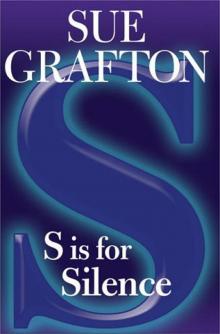 S Is for Silence
S Is for Silence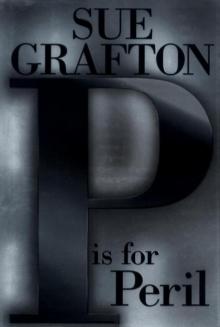 P Is for Peril
P Is for Peril R Is for Ricochet
R Is for Ricochet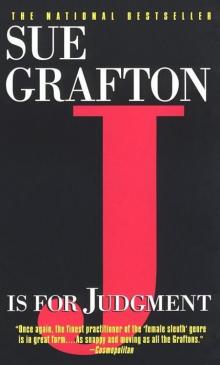 J Is for Judgment
J Is for Judgment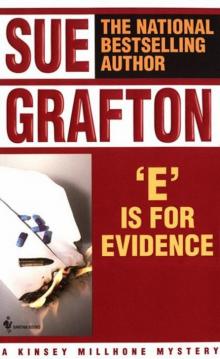 E Is for Evidence
E Is for Evidence T Is for Trespass
T Is for Trespass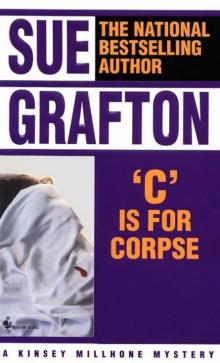 C Is for Corpse
C Is for Corpse U Is for Undertow
U Is for Undertow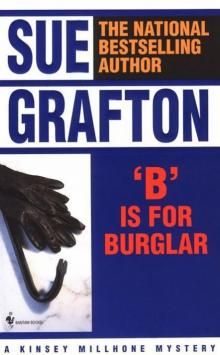 B Is for Burglar
B Is for Burglar Four Sue Grafton Novels
Four Sue Grafton Novels D Is for Deadbeat
D Is for Deadbeat K Is for Killer
K Is for Killer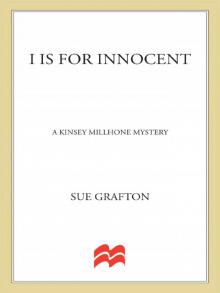 I Is for Innocent
I Is for Innocent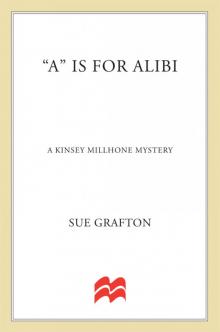 A Is for Alibi
A Is for Alibi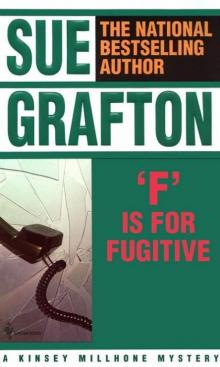 F Is for Fugitive
F Is for Fugitive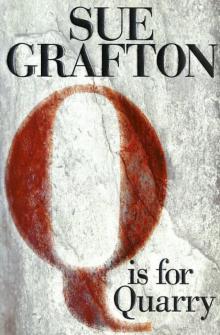 Q Is for Quarry
Q Is for Quarry W Is for Wasted
W Is for Wasted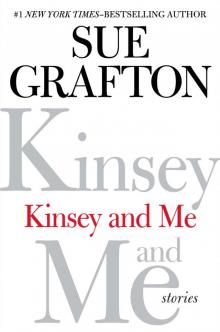 Kinsey and Me: Stories
Kinsey and Me: Stories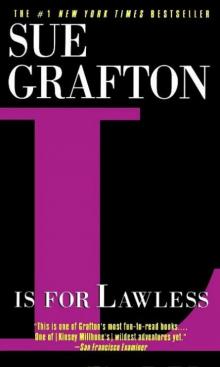 L Is for Lawless
L Is for Lawless Y Is for Yesterday
Y Is for Yesterday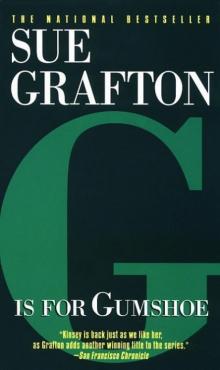 G Is for Gumshoe
G Is for Gumshoe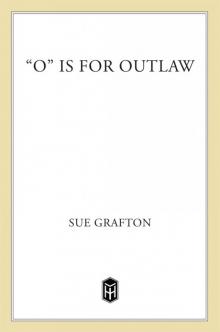 O Is for Outlaw
O Is for Outlaw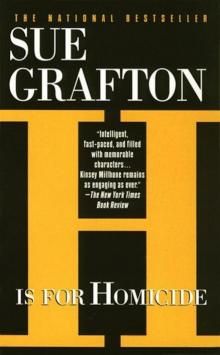 H Is for Homicide
H Is for Homicide X
X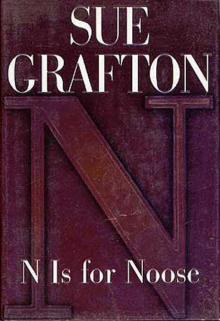 N Is for Noose
N Is for Noose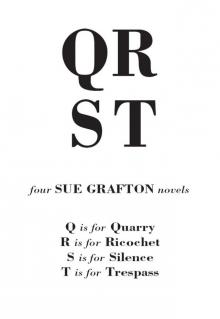 Three Complete Novels: A Is for Alibi / B Is for Burglar / C Is for Corpse
Three Complete Novels: A Is for Alibi / B Is for Burglar / C Is for Corpse M Is for Malice
M Is for Malice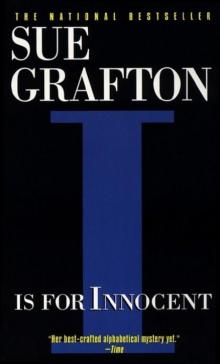 I is for INNOCENT
I is for INNOCENT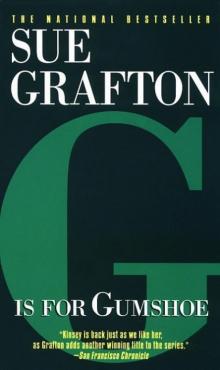 G is for GUMSHOE
G is for GUMSHOE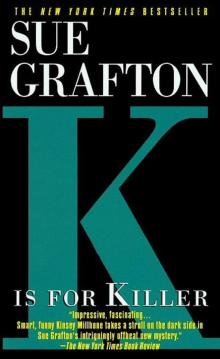 K is for KILLER
K is for KILLER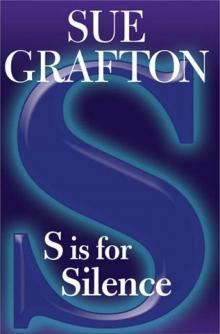 S is for SILENCE
S is for SILENCE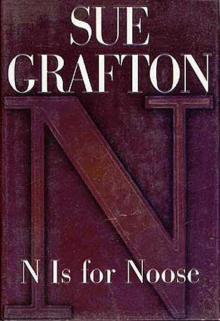 N is for NOOSE
N is for NOOSE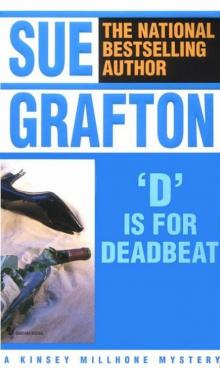 D is for DEADBEAT
D is for DEADBEAT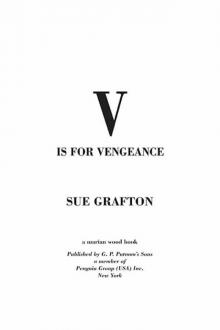 V is for Vengeance
V is for Vengeance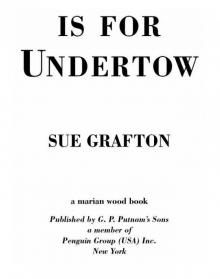 U is for Undertow
U is for Undertow W Is for Wasted km-23
W Is for Wasted km-23 O is for OUTLAW
O is for OUTLAW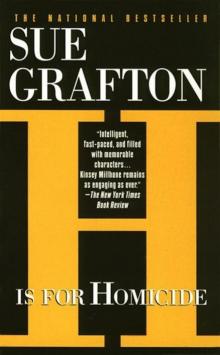 H is for HOMICIDE
H is for HOMICIDE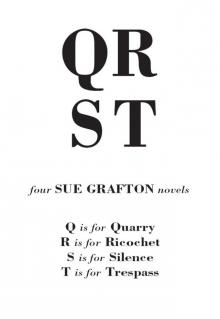 Sue Grafton Novel Collection
Sue Grafton Novel Collection Kinsey and Me
Kinsey and Me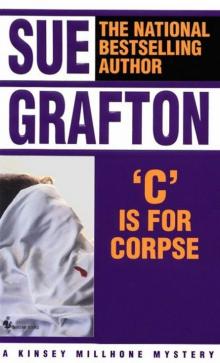 C is for CORPSE
C is for CORPSE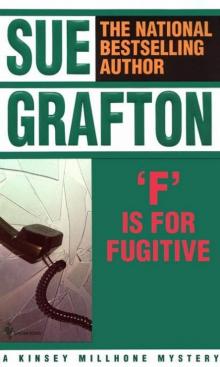 F is for FUGITIVE
F is for FUGITIVE B is for BURGLAR
B is for BURGLAR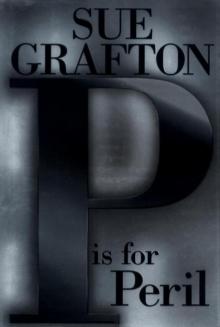 P is for PERIL
P is for PERIL A is for ALIBI
A is for ALIBI E is for EVIDENCE
E is for EVIDENCE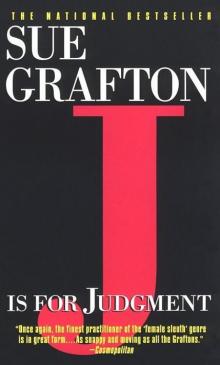 J is for JUDGMENT
J is for JUDGMENT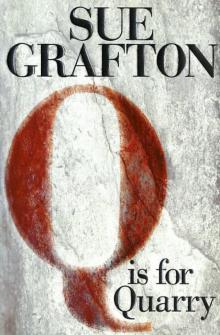 Q is for QUARRY
Q is for QUARRY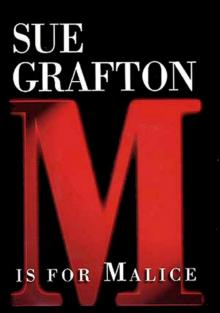 M is for MALICE
M is for MALICE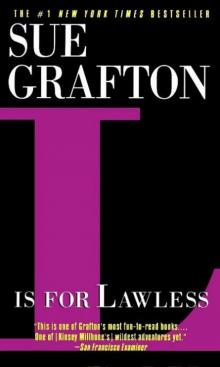 L is for LAWLESS
L is for LAWLESS